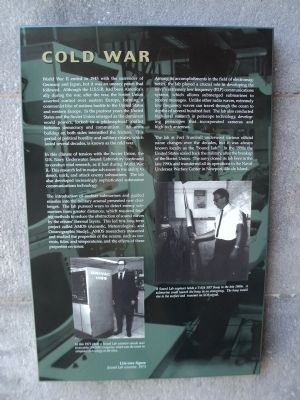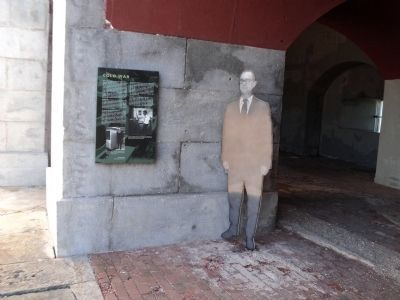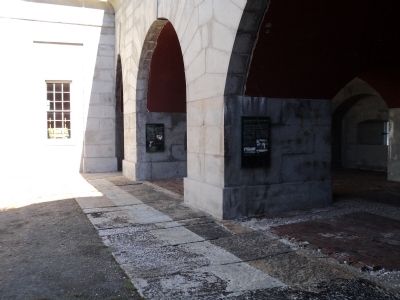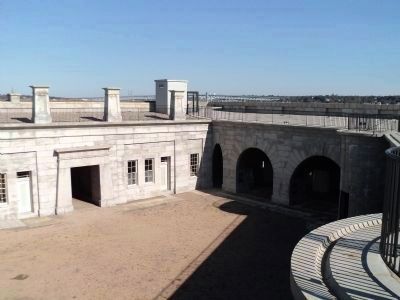Fort Trumbull in New London in New London County, Connecticut — The American Northeast (New England)
Cold War
World War II ended in 1945 with the surrender of Germany and Japan, but it was an uneasy peace that followed. Although the U.S.S.R. had been America’s ally during the war, after the war, the Soviet Union asserted control over eastern Europe, forming a communist bloc of nations hostile to the United States and western Europe. In the postwar years the United States and the Soviet Union emerged as the dominant world powers, locked in a philosophical conflict between democracy and communism. An arms buildup on both sides intensified the friction. This period of political hostility and military rivalry, which lasted several decades, is known as the cold war.
In this climate of tension with the Soviet Union, the U.S. Navy Underwater Sound Laboratory continued to conduct vital research, as it had during World War II. This research led to major advances in the ability to detect, track, and attack enemy submarines. The lab also developed increasingly sophisticated submarine communications technology.
The introduction of nuclear submarines and guided missiles into the military arsenal presented new challenges. The lab pursued ways to detect enemy submarines from greater distances, which required finding methods to reduce the obstruction of sound waves by the oceans’ thermal layers. This led to a long-term project called AMOS (Acoustic, Meteorological, and Oceanographic Study). AMOS researchers measured and studied the properties of the oceans, such as currents, tides, and temperatures, and the effects of these properties on sonar.
Among its accomplishments in the field of electromagnetics, the lab played a crucial role in developing the navy’s extremely low frequency (ELF) communications system, which allows submerged submarines to receive messages. Unlike other radio waves, extremely low frequency waves can travel through the ocean to depths of several hundred feet. The lab also conducted high-level research in periscope technology, developing periscopes that incorporated cameras and high-tech antennas.
The lab at Fort Trumbull underwent various official name changes over the decades, but it was always known locally as the “Sound Lab.” In the 1990s the United States scaled back the military, after the breakup of the Soviet Union. The navy closed its lab here in the late 1990s and transferred all its operations to the Naval Undersea Warfare Center in Newport, Rhode Island.
Erected by Fort Trumbull State Park.
Topics. This historical marker is listed in these topic lists: Science & Medicine • War, Cold. A significant historical year for this entry is 1945.
Location. 41° 20.628′ N, 72° 5.595′ W. Marker
is in New London, Connecticut, in New London County. It is in Fort Trumbull. Marker can be reached from East Street, on the left when traveling south. Marker is located inside the fort at Fort Trumbull State Park. Touch for map. Marker is in this post office area: New London CT 06320, United States of America. Touch for directions.
Other nearby markers. At least 8 other markers are within walking distance of this marker. Scientific Research (here, next to this marker); Merchant Marine (a few steps from this marker); a different marker also named Scientific Research (a few steps from this marker); Bottom Reflected Active Sonar System (BRASS) (a few steps from this marker); “Aim, Load, Fire” (a few steps from this marker); Fort Trumbull (within shouting distance of this marker); Post Civil War to 1910 (within shouting distance of this marker); Coast Guard (within shouting distance of this marker). Touch for a list and map of all markers in New London.
More about this marker. Two photographs appear at the bottom of the marker. The one on the left has a caption of “In this 1973 photo, a Sound Lab scientist stands next to an early UNIVAC computer, which was the latest in computer technology at the time.” To the right is a picture with the caption “A Sound Lab engineer holds a T-616 SRT Buoy in the late 1960s. A submarine could launch the buoy in an emergency. The buoy would rise to the surface and transmit and SOS signal.”
Also see . . . History of Fort Trumbull. Friends of Fort Trumbull. (Submitted on October 16, 2011, by Bill Coughlin of Woodland Park, New Jersey.)
Credits. This page was last revised on February 10, 2023. It was originally submitted on October 16, 2011, by Bill Coughlin of Woodland Park, New Jersey. This page has been viewed 692 times since then and 10 times this year. Photos: 1, 2, 3, 4. submitted on October 16, 2011, by Bill Coughlin of Woodland Park, New Jersey.



